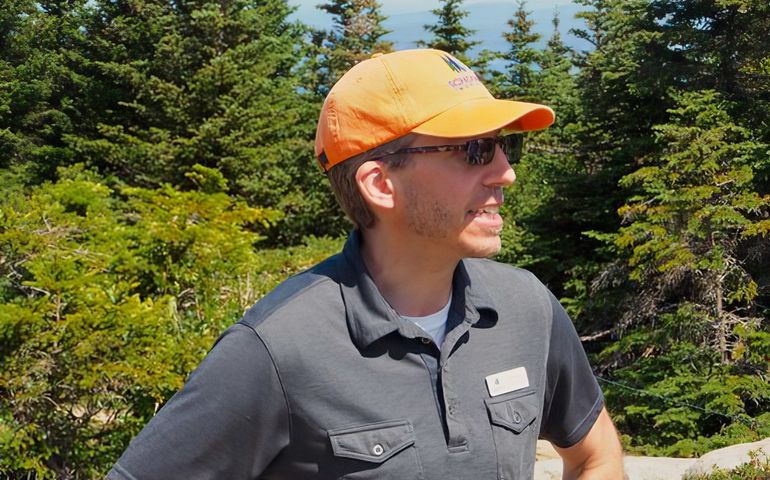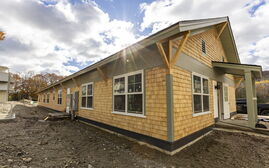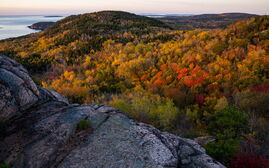New Schoodic Institute CEO tackles climate change
 Courtesy / Nicholas Fisichelli
Nicholas Fisichelli, Schoodic Institute’s new president/CEO, says the institute plays an important role in understanding climate change issues in Acadia National Park and across the national park system.
Courtesy / Nicholas Fisichelli
Nicholas Fisichelli, Schoodic Institute’s new president/CEO, says the institute plays an important role in understanding climate change issues in Acadia National Park and across the national park system.
Schoodic Institute’s new president and CEO is a forest ecologist with plenty of experience in climate change response.
The Winter Harbor nonprofit’s board of directors appointed Nicholas Fisichelli to the position five months after they named him interim director. Fisichelli previously served as the institute’s director of science and education. He joined Schoodic in 2016 and established its forest ecology program.
Fisichelli worked for the National Park Service Climate Change Response Program developing and applying management-relevant science, including global change impacts to forests, plant and wildlife species, protected area operations, and visitor experience. He was a Fulbright fellow in Germany and earned his Ph.D. in forest ecology from the University of Minnesota in 2012. He also previously worked at Shenandoah and Lassen Volcanic National Parks.
The nonprofit, located within Acadia National Park, is the largest of 18 National Park Service research learning centers in the United States.
Mainebiz asked Fisichelli for his observations about climate change impacts in Acadia and the institute’s role in addressing them.
Mainebiz: How is Schoodic Institute working on climate change?
Nicholas Fisichelli: We’re living in an era of continuous and accelerating change and we know the future will look different from the recent past and that proactive responses are needed. Our role is to engage people in this work. There’s no one-size-fits-all solution. It will vary depending on locations and time frames of the issue and the resource that’s being managed.
The next generation will be dealing with a lot of challenges related to climate change. Our role is to provide the tools and the skills, the science and the data literacy that people need. A lot of our work is in the parks, but these skills are transferable to local communities and to other natural resource-based economies such as we have here in rural Maine.
MB: What are you seeing for specific impacts in Acadia National Park?
NF: In this region, we’re seeing warmer temperatures. We’re seeing changes in precipitation, with more heavy-rainfall events and associated erosion. In the last four decades, there’s been roughly a six-week extension of the growing season. And we’re seeing less cold temperatures in the winter and increasing survival of forest pests. We’re seeing changes in bird assemblages: which bird species are found here and when they migrate. Layer on other factors such as non-native forest pests, habitat fragmentation and changes in land use.
MB: Can you provide an example of how you engage people in the issue of climate change?
NF: Citizen science is one of the tools we utilize. One example is the work we’re doing here with the local school district. The project is called CSI Maine, for “community science investigation.” Right now, they’re looking at clams and mud flats, which are managed at the local level by towns. There are a lot of questions around clam survival and the impacts of invasive green crabs. Our educators are working with the local school district to engage students at the high school and middle school level in figuring out what’s happening in these mud flats and providing recommendations to town managers to figure out, for example, where to plant seed clams.
A lot of students don’t necessarily see science as important to their livelihoods. But we’re trying to change that and show how data literacy, scientific inquiry, and experiments are critical to responding to changing conditions.
MB: What’s the institute’s role in addressing these changes?
NF: We know the future is going to look different from the past. Some species will survive and do well, and other species will struggle with the shifts in conditions. Take red spruce, for example. It’s the iconic tree species of Acadia National Park and the most abundant tree in the park; some 40% of the forest is red spruce. It’s a species that’s projected to struggle with continued climate change. It doesn’t like hot conditions or drought. Projections show it will lose about half of its suitable habitat in the Downeast region. So the question we’re working on now, based on computer modeling for suitable habitat, is to better understand just how sensitive the species is to changes in temperature by running experiments on seedlings. If the species is going to lose, say, half of its suitable habitat, that means it will also retain half. So where are the areas that are likely to be the refugia for red spruce and what management actions are needed to foster healthy forests?
We’re doing that work with Acadia and working with parks across the region across. We just started a project to assess forest health across 40 parks from Maine to Virginia and to establish healthy-forest benchmarks and management options for responding to changes in these park forests.
MB: What comes after you identify things like red spruce refugia?
NF: We’re working with managers to identify a toolbox of climate change responses. It might be things such as reducing other stressors. For example, removing an exotic plant like glossy buckthorn or other nonnative species that might be stressors on native species like red spruce. And we’re doing experiments to see what will be the next species that will do well in a changing climate.
MB: Can you describe one of your experiments?
NF: We have experiments happening at eight campuses across Maine: Schoodic, four University of Maine campuses, the University of New England, and Colby and Unity colleges. We’re growing the same 12 tree species, using the large climate gradients across the state of Maine, to get an inference of how these species will respond to ongoing climate change.
MB: What’s your vision for the institute going forward?
NF: We’ll continue our focus on responding to global climate change. A paradigm shift is happening for conservation, for park management, and for local communities as well: a shift from managing for the past to managing for continuous change. Our work helps Acadia and local communities, but we’re also able to take our work across the National Park System. One major initiative is Second Century Stewardship, bringing the next century of science, communication and engagement to parks across the country.













0 Comments